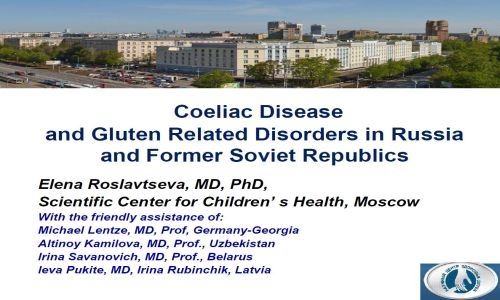What is celiac disease?

Celiac disease is a common genetically mediated autoimmune enteropathy triggered by the ingestion of gluten.
Celiac disease is a permanent intolerance to gluten proteins found in a number of widely consumed cereal grains; including wheat, barley, spelt, rye, KAMUT®, and triticale [1]. In children and adults with genetic predisposition, the ingestion of foods containing gluten causes an autoimmune reaction in the intestine. This results in chronic inflammation of the small intestinal mucosa and truncation of the villi, therefore reducing the absorptive capacity of the small intestine. If untreated, these characteristic histopathological changes result in malabsorption of key micronutrients and consequent nutritional deficiencies. While intestinal damage is the hallmark of celiac disease, presentation of symptoms ca vary from the classic gastrointestinal to skin manifestations of Dermatitis Herpetiformis to infertility and bone loss [2]. However, adherence to a strict gluten-free diet allows regeneration of the villi and resolution of symptoms. A lifelong gluten-free diet, in which all traces of gluten are avoided, is currently the only treatment available for the management of this condition.
Prevalence
Celiac disease is more common than is often assumed. In North America, 1 in 100 people are believed to have celiac disease, yet current research shows only 24% are actually diagnosed [3,4,5] largely due to the diverse presenting symptomatology.
Oslo definitions of celiac disease
Due to lack of consensus on the use of terms related to celiac disease and gluten, a multi-disciplinary task force of international physicians was convened to agree a set definitions for the various types of celiac disease based on presentation and symptoms, these were updated in 2013, and are referred to as ‘the Oslo definitions’ for celiac disease and related terms [6].
Classical celiac disease
Celiac disease presenting with signs and symptoms of malabsorption. Diarrhoea, steatorrhoea, weight loss or growth failure is required.
Non-classical celiac disease
Celiac disease presenting without signs and symptoms of malabsorption.
Subclinical celiac disease
Celiac disease that is below the threshold of clinical detection and without signs or symptoms sufficient to trigger coeliac testing in routine practice.
Symptomatic celiac disease
Celiac disease characterised by clinically evident gastrointestinal and/or extraintestinal symptoms attributable to gluten intake.
Potential celiac disease
Individuals with a normal small intestinal mucosa who are at increased risk of developing celiac disease as indicated by positive celiac serology.
Refractory celiac disease
Persistent or recurrent malabsorptive symptoms with villous atrophy despite a strict gluten free diet for more than 12 months.
References
- Green, P.H.R., & Jabri, B. (2006). Celiac Disease. Annual Reviews Medicine, 57, 14.1 14.15.
- Rubio-Tapia, A., Ludvigsson, J.F., Bantner, T.L., Murray, J.A., & Everhart, J.E. (2012). The prevalence of celiac disease in the United States. Am J Gastroenterology, 107 (10); 1538 44.
- West J, Logan RFA, Hill PG et al. Seroprevalence, correlates and characteristics of undetected coeliac disease in England. Gut 2003; 52:960-965
- Bingley PJ, Williams AJK, Norcross AJ et al. Undiagnosed coeliac disease at age seven: population-based prospective birth cohort study. BMJ 2004; 328:322-323
- West J, Fleming KM, Tata LJ et al. Incidence & Prevalence of celiac disease and dermatitis herpetiformis in the UK over two decades: Population-based study. American Journal of Gastroenterology 2014; 109:757-768.
- Ludvigsson JF, Leffler DA, Bai J. The Oslo definitions for coeliac disease and related terms. Gut 2013; 62:43-52.
Other chapters in the field of celiac disease:
Further information on this topic
Professional articles
1
Show all
Presentations
1
Show all
Studies
1
Show all

Celiac disease: the clinical chameleon
The chameleon is a well-known African rep-tile famous for its ability to change the color of its skin in order to blend in with its sur-roundings. In medicine, the term “chame-leon-like” is used to describe diseases which can appear in many different forms. Celiac disease, with its diverse, ever-changing nature, is one such disease.
>> Read more... <<<
>> Read more... <<<

Celiac disease: the clinical chameleon
The chameleon is a well-known African rep-tile famous for its ability ...

Coeliac Disease and Gluten Related Disorders in Russia and Former Soviet Republics (2015)
Elena Roslavtseva, MD, Ph.D.
Scientific Center for Children’s Health, Moscow
16th International Coeliac Disease Symposium 2015 in Prague
Pre-Conference Workshop on Gluten Sensitivity "The Evolving Planet of Gluten Related Disorders"
Scientific Center for Children’s Health, Moscow
16th International Coeliac Disease Symposium 2015 in Prague
Pre-Conference Workshop on Gluten Sensitivity "The Evolving Planet of Gluten Related Disorders"

Coeliac Disease and Gluten Related Disorders in Russia and Former Soviet Republics (2015)
Elena Roslavtseva, MD, Ph.D.
Scientific Center for Children’s Health,...

Celiac Disease: Ten Things That Every Gastroenterologist Should Know
There are 10 things that all gastroenterologists should know about celiac disease (CD).
(1) The immunoglobulin A tissue transglutaminase is the single best serologic test to use for the detection of CD.
(2) CD can be recognized endoscopically, and water immersion enhances villi detection, although a normal endoscopic appearance does not preclude the diagnosis.
(3) It is recommended that 4 biopsies be taken from the second part of the duodenum and 2 bulb biopsies be taken at the 9 o’clock and 12 o’clock positions to maximize the sensitivity for histologic confirmation of CD.
(4) Consider serologic testing of first-degree relatives, patients with type 1 diabetes mellitus, Down’s, Turner’s, and Williams’ syndromes, as well as those with premature osteoporosis, iron deficiency, abnormal liver biochemistries, and other manifestations of CD.
(5) Patients already on a prolonged gluten-free diet (GFD) should be tested for the presence of HLA DQ2 or DQ8, thereby avoiding the need for further evaluation of CD in non-allelic carriers.
(6) The basic treatment of CD is a strict, lifelong GFD, enabled by an expert dietitian.
(7) Newly diagnosed adults with CD should be assessed for micronutrient deficiencies (iron, B12, folate, zinc, copper), fat soluble vitamin deficiencies (vitamin D), and bone densitometry.
(8) All patients diagnosed with CD should have clinical follow-up to ensure response and adherence to a GFD.
(9) In those with persistent or relapsing symptoms, the robustness of the original diagnosis should be reviewed, gluten exposure sought, and a systematic evaluation for alternative and associated diseases performed.
(10) Evaluate those with refractory disease for malignant transformation.
Resource: Clin Gastroenterol Hepatol. 2014 Jul 19. pii: S1542-3565(14)01053-2
(1) The immunoglobulin A tissue transglutaminase is the single best serologic test to use for the detection of CD.
(2) CD can be recognized endoscopically, and water immersion enhances villi detection, although a normal endoscopic appearance does not preclude the diagnosis.
(3) It is recommended that 4 biopsies be taken from the second part of the duodenum and 2 bulb biopsies be taken at the 9 o’clock and 12 o’clock positions to maximize the sensitivity for histologic confirmation of CD.
(4) Consider serologic testing of first-degree relatives, patients with type 1 diabetes mellitus, Down’s, Turner’s, and Williams’ syndromes, as well as those with premature osteoporosis, iron deficiency, abnormal liver biochemistries, and other manifestations of CD.
(5) Patients already on a prolonged gluten-free diet (GFD) should be tested for the presence of HLA DQ2 or DQ8, thereby avoiding the need for further evaluation of CD in non-allelic carriers.
(6) The basic treatment of CD is a strict, lifelong GFD, enabled by an expert dietitian.
(7) Newly diagnosed adults with CD should be assessed for micronutrient deficiencies (iron, B12, folate, zinc, copper), fat soluble vitamin deficiencies (vitamin D), and bone densitometry.
(8) All patients diagnosed with CD should have clinical follow-up to ensure response and adherence to a GFD.
(9) In those with persistent or relapsing symptoms, the robustness of the original diagnosis should be reviewed, gluten exposure sought, and a systematic evaluation for alternative and associated diseases performed.
(10) Evaluate those with refractory disease for malignant transformation.
Resource: Clin Gastroenterol Hepatol. 2014 Jul 19. pii: S1542-3565(14)01053-2

Celiac Disease: Ten Things That Every Gastroenterologist Should Know
There are 10 things that all gastroenterologists should know about cel...
www.drschaer-institute.com
